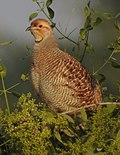|
Lankaran Lowland The Lankaran Lowland (Azerbaijani: Lənkəran ovalığı) is a narrow strip of lowland in southern Azerbaijan by the Caspian Sea. It is the southward extension of the Kura-Aras Lowland which in itself is an extension of the Aral–Caspian Depression. It is named after the city of Lankaran. GeographyIt joins the Mughan plain in the North and is bounded by the Caspian Sea from the East, the Talysh Mountains southwards and reaches Iran in the area of Astara by the sea and westwards. The plain part of the Hirkan National Park ("Moscow Forest") lies within the Lankaran Lowland. The Moscow Forest is the only preserved part of the Caspian Hyrcanian mixed forests which covered most of the lowland, that was later cleared for agriculture.[1] However, there is a reforestation program of the lowland, on a designated non-forested lot which is the only non-cultivated land on the plain, in order to (partially because the Lankaran Lowland is far too valuable for its agricultural productivity for Azerbaijan, to be given up for reforestation) restore the ecology to its previous forested state. This lot will become the second forest in the lowland after the Moscow Forest and once it is reforested, it will become an additional part of the Hirkan National Park in the lowland.[2] ClimateThe lowland with its humid semi-subtropical climate is a place of tea, rice and citrus plantations. The maximum annual precipitation in Lankaran Lowland is between 1,600 mm to 1,800 mm, which along the Talysh Mountains is the highest precipitation in Azerbaijan. Fauna
See also
References
|





